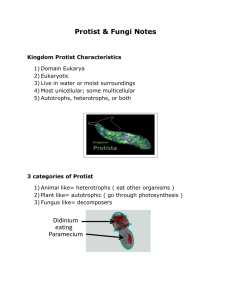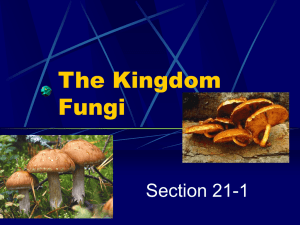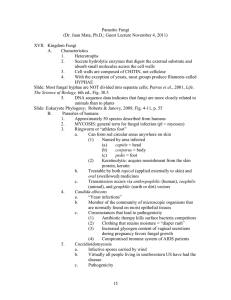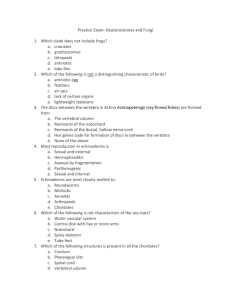Chapter 14 Fungi
advertisement
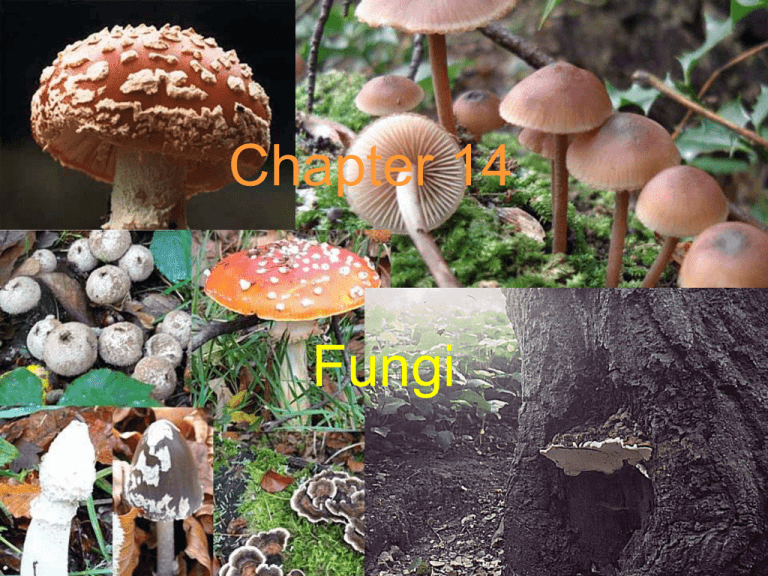
Chapter 14 Fungi Importance of Fungi Together with Heterotrophic bacteria Ecological decomposers Decomposing fruit- Rhizopus Root-rot fungus- white mycelial causes disease in living trees Acts as decomposers on dead plants Root rot Ouch!!! Fungi • Composed of Hyphae • Heterotrophic absorbers Characteristics of Fungi • Composed of Hyphae Fungal filaments= “Cobwebby” strands of subterranean “white stuff” Mycelium Fungi form important symbiotic relationships • 80% of all vascular plants species from mutually beneficial associations called mycorrhizae between roots and fungi • Plant nutrition • Lichens form symbiotic relationship with fungi, algal, or cyanobacterial cells Four phyla of fungi • Chytridiomycota • Zygomycota • Ascomycota • Basidiomycota Chars of Fungi • All have cell wall • Cell wall composed of polysaccharide- chitin • Chitin more resistant to microbial degradation than cellulose All Fungi Heterotrophic Absorbers • Unable to engulf small microorganisms • Secrete enzymes and absorb smaller molecules •Absorb food mostly at or near the growing tips of their hyphae Fungi obtain their food • Either as Saprophytes or • As mutualistic symbionts Some • Obtain energy through fermenation producing ethyl alcohol from glucose (i.e. yeast) Fungi reproduce both sexually and asexually • Reproduce through the formation of spores that are produced sexually or asexually • Most are nonmotile spores • Some are dry and small and airborne Common method of asexual reproduction in fungi By means of spores • Either produced in sporangia – The sporangium is a saclike structure, the entire contents of which are converted into one or more spores Asexual reproduction (Vegetative reproduction) Or • Hyphal cells called conidiogenous cells – Spores produced by conidiogenous cells occur singly or in chains called conidia Asexual repro • Some Reproduce by fragmentation of their hyphae Sexual reproduction • Three distinct phases • First two are phases of fertilization (syngamy) – Plasmogamy- the fusion of protoplasts – Karyogamy- the fusion of nuclei (some don’t fuse forming a dikaryon) The last phase is meiosis • Sexual reproduction results in the formation of specialized spores such as zygospores, ascospores, basidiospores. Zygospores • Zygospores • Asexual and sexual reproduction (by means of haploid spores) • Sexually producing zygospores require two compatible species Gametangia the gamete producing structures are in the Process of producing a zygospore Zygomycetes: Phylum Zygomycota • Live on decaying plant and animal matter in soil • Some are parasites of plants, insects or small soil animals • Rhizopus stolonifer- best known zygomycetes Life cycle of Rhizopus stolonifer Zygospore develops within the thick walled zygosporangium Ascomycetes: Phylum Ascomycota Ascomycetes • Group of fungi characterized by their production of sexual spores in a sac-like structure called an ascus. “Cup fungus” Types of Ascomycete • yeast • powdery mildew • cup fungi – many of these produce spores suited for airborne dispersion. The Ascomycota •Most are blue-green, red and brown molds that cause food spoilage • Non motile •Penicillin •Form ascospores Internally in Asci Ascomycetes Eyelash cup, Scutellinia scutellata Ascomycetes can cause plant disease • Brown rot of stone fruits (Monilinia fructicola) •chestnut blight (Cryphonectria parasitica) Dutch elm disease ( Ophiostoma ulmi) Beneficial Ascomycete • Many Yeast are also ascomycetes •Edible Morels and truffles Edible black truffle, Tuber melanosporum spore-bearing structure is produced below ground mainly on oaks and hazelnuts Edible Ascomycete Ascomycetes growth • Most have either unicellular or filamentous growth forms • Hyphae have perforated septa • Hyphal cells of Vegetative mycelim may be either uninucleated or multinucleated Life cycle of an Ascomycete • Most species undergo asexual reproduction by the formation of multinucleated conidia • Conidia formed from the conidiogenous cells • Conidiogeneous cells are borne at the tips of modified hyphae called conidiophores “conidia bearers” Ascomycetes spore development vs. Zygomycetes spore development • Unlike zygomycetes which produce spores internally within a sporangium, ascomycetes produce their asexual spores externally as conidia. Xylaria fungus Perithecium with ascospores “Dead mans fingers” Finger Xsec Hymenial layer • Asci usually develop on an inner surface of the asoma, a layer called the hymenium or hymenial layer Hymenium of an ascomycete showing asci with ascospores section thru the hymenial layer of Morela Ascomycete life cycle Basidiomycota Life cycle of Basidiomycota As a group, the basidiomycota have some highly characteristic features, which separate them from other fungi. germinate monokaryons Single nucleus Each w/ 1n. fusion of a hypha with a small spore simple hyphal fusions dikaryon nuclei divide They are the most evolutionarily advanced fungi, and even their hyphae have a distinctly "cellular" composition. • Many basidiomycota grow for most of their lives as dikaryons, until environmental signals induce them to produce fruitbodies • At a late stage of development, some of these hyphae produce special cells termed basidia (singular, basidium). • cells that line the gills of the common mushroom are basidia • Finally, the two haploid nuclei in each basidium fuse - a process termed karyogamy) to form a diploid nucleus. • This then undergoes meiosis to produce four haploid nuclei • these haploid nuclei migrate into the basidiospores • which develop on small stalks (termed sterigmata) from each basidium • The dispersal of these monokaryotic spores completes the life cycle. Basidia on the gills of a toadstool. Basidiospores basidium sterigmata Basidiospores Class basidiomycetes • Hymenomycetes • Gasteromycetes Hymenomycetes Muscimol Fly agaric Amanita muscaria Agaricus Bisporus Portobella Lentinula edodes Shiitake Amanita virosa lpha-amanitin Volva annulus “Death angel” Polyporus arcularius “Shelf fungus” Ganoderma applanatum “Fairy rings” Fruitbodies “Puffball” “Puffballs” peridium Gasteromycetes Earth stars Earthstar The netted stinkhorn Gastermycetes Class Teliomycetes “Rust” Blackberrry leaf “Corn smut” Ustilago maydis Hallucinogenic mushrooms Psilocybe mexicana Crustose and foliose lichen Foliose “leafy” lichen Hummingbirds nest Witch’s hair Raindeer moss Fruticose “shrubby” lichens


